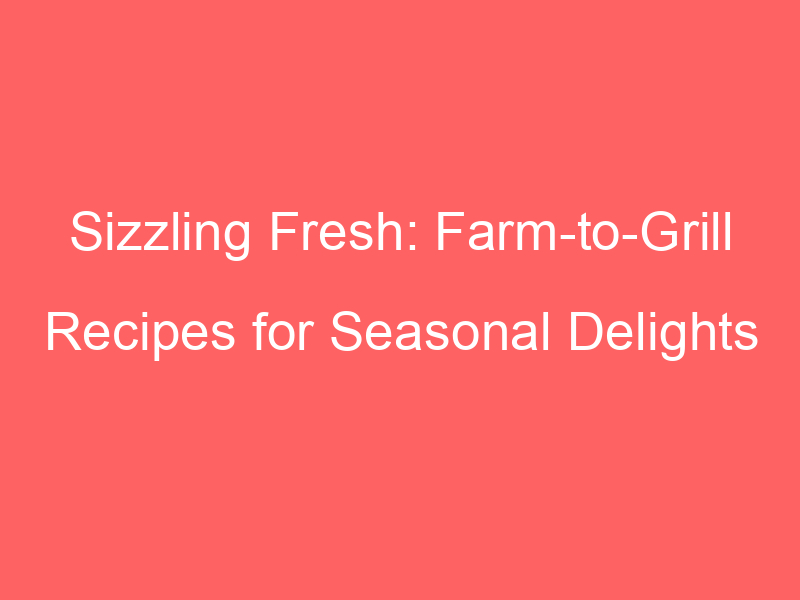Introduction to Farm-to-Grill Cooking
Welcome to the exciting world of Farm-to-Grill cooking! This method of preparing food is all about using fresh, seasonal ingredients straight from the farm and cooking them on the grill. It’s a fun, healthy, and delicious way to enjoy your meals. Let’s dive into the details.
- Understanding the concept of Farm-to-Grill
- Benefits of Seasonal Eating
- Nutritional Value: Seasonal produce tends to be more nutritious as it is harvested at its peak when it’s fully ripe and packed with vitamins and minerals.
- Taste: Foods grown in their proper seasons have more flavor and are generally tastier.
- Environmentally Friendly: Eating seasonally reduces the demand for out-of-season produce which often requires more energy to grow and transport, thus helping the environment.
- Supports Local Economy: When you buy seasonal produce, you’re more likely to be supporting local farmers, which helps boost your local economy.
Farm-to-Grill is a cooking philosophy that emphasizes the use of fresh, locally sourced, and seasonal ingredients. The idea is to reduce the distance food travels from the farm to your plate, ensuring you get the freshest and most nutritious ingredients. The ‘Grill’ part of Farm-to-Grill refers to the cooking method, which adds a unique flavor to the food and allows for a healthier way of cooking as it requires less oil and retains more nutrients.
Eating seasonally means consuming fruits and vegetables when they are naturally ripe and at their peak. This not only results in better-tasting food but also offers several health and environmental benefits. Here are a few:
Now that you understand the concept of Farm-to-Grill cooking and the benefits of eating seasonally, you’re ready to explore the rest of this guide. We’ll cover everything from choosing the best farm-fresh produce for grilling to mastering the art of grilling seasonal foods. Let’s get started!
Farm Fresh Recipes: A Seasonal Guide
As the seasons change, so do the fresh produce available on farms. This guide will help you make the most of each season’s bounty with delicious, farm-fresh recipes. Let’s start with spring, a season of renewal and fresh beginnings.
Spring
Spring is a time when the earth comes alive again. The farm is abundant with fresh and tender produce. Here are two recipes that make the most of what spring has to offer.
- Grilled Asparagus with Lemon Butter
- Preheat your grill to medium heat.
- Wash and trim the asparagus spears.
- Drizzle with olive oil and season with salt and pepper.
- Grill for 3-4 minutes on each side until tender and slightly charred.
- Meanwhile, melt butter and mix with the zest and juice of one lemon.
- Drizzle the lemon butter over the grilled asparagus before serving.
- Spring Onion and Pea Risotto
- Heat olive oil in a pan and sauté chopped spring onions until soft.
- Add Arborio rice and cook until translucent.
- Gradually add vegetable stock, stirring constantly until the rice has absorbed the liquid.
- When the rice is almost done, add fresh peas and cook until tender.
- Finish with a generous amount of grated Parmesan cheese and serve immediately.
Asparagus is a spring vegetable that’s at its best this time of year. Grilling asparagus brings out its natural sweetness. Pair it with a tangy lemon butter for a refreshing side dish. Here’s how:
Spring onions and peas are both in season during spring. This risotto recipe is a creamy and comforting dish that showcases these ingredients.
These recipes not only taste delicious but also make the most of fresh, seasonal produce. Cooking with the seasons is a great way to support local farmers and enjoy food at its peak of flavor.
Summer
As the sun shines brighter and the days get longer, the summer season brings a bounty of fresh produce perfect for grilling. Let’s explore two delightful recipes that are sure to be the stars of your summer BBQs.
-
Grilled Corn with Spicy Mayo
Nothing screams summer like the sweet crunch of fresh corn. This recipe takes it up a notch by adding a kick of spicy mayo. Here’s how to make it:
Ingredients Instructions Fresh corn, mayonnaise, chili powder, lime Grill the corn until charred, mix mayo with chili powder, slather the mixture on the corn, and finish with a squeeze of lime. This dish is a perfect blend of sweet, spicy, and tangy flavors, making it a summer favorite.
-
Summer Berry Salad with Grilled Chicken
For a lighter option, this salad combines the freshness of summer berries with the smoky flavor of grilled chicken. Here’s the recipe:
Ingredients Instructions Mixed berries, grilled chicken, mixed greens, vinaigrette Grill the chicken until cooked, toss the mixed greens and berries in vinaigrette, top with sliced grilled chicken. This salad is not only delicious but also packed with nutrients, making it a healthy choice for summer meals.
These recipes showcase the versatility of fresh, farm-to-grill cooking. Whether you prefer a spicy kick or a light and refreshing dish, summer offers an abundance of options to satisfy your palate.
Fall: A Season of Rich Flavors and Warm Colors
As the leaves change color and the air turns crisp, our farm-to-grill recipes also transition to embrace the bounty of the fall season. This autumn, we’re featuring two delightful dishes that highlight the unique flavors of fall produce: Grilled Butternut Squash with Sage and Apple and Fennel Slaw.
-
Grilled Butternut Squash with Sage
The butternut squash, with its sweet, nutty flavor, is a fall favorite. When grilled, it takes on a smoky flavor that pairs beautifully with the earthy aroma of sage. This dish is not only delicious but also packed with vitamins A and C, making it a healthy choice for your fall grilling menu.
Ingredients Instructions 1 medium butternut squash, 2 tablespoons olive oil, Salt and pepper to taste, 2 tablespoons chopped fresh sage Peel and slice the butternut squash. Toss in olive oil, salt, and pepper. Grill over medium heat until tender. Sprinkle with fresh sage before serving. -
Apple and Fennel Slaw
Our Apple and Fennel Slaw is a refreshing side dish that adds a crisp, tangy contrast to your grilled mains. The anise-like flavor of the fennel combines perfectly with the sweet-tartness of the apples, creating a slaw that’s both flavorful and visually appealing with its vibrant colors.
Ingredients Instructions 2 apples, 1 fennel bulb, 1/4 cup apple cider vinegar, 1 tablespoon honey, Salt and pepper to taste Slice the apples and fennel thinly. In a bowl, whisk together the apple cider vinegar, honey, salt, and pepper. Toss the apples and fennel in the dressing until well coated.
These fall recipes are a testament to the beauty of farm-to-grill cooking. By using fresh, seasonal produce, we can create dishes that are not only delicious but also celebrate the season’s bounty. Happy grilling!
Winter
As the temperature drops and the snow begins to fall, it’s time to adjust our grilling recipes to match the season. Winter brings with it a bounty of root vegetables and citrus fruits that are perfect for grilling. Let’s explore two delicious, farm-fresh recipes that you can prepare on your grill during the winter season.
- Grilled Root Vegetables with Rosemary
Root vegetables like carrots, parsnips, and beets are at their best during the winter months. Grilling these vegetables brings out their natural sweetness, while the addition of rosemary adds a fragrant, earthy flavor. Here’s a simple recipe to try:
| Ingredients | Instructions |
|---|---|
|
|
- Winter Citrus Salad
Winter is the peak season for citrus fruits like oranges, grapefruits, and lemons. A citrus salad is a refreshing side dish that pairs well with grilled meats. Here’s a simple recipe to try:
| Ingredients | Instructions |
|---|---|
|
|
These winter recipes not only taste great, but they also make use of fresh, seasonal produce. By choosing farm-fresh ingredients, you’re supporting local farmers and ensuring that your food is as nutritious and flavorful as possible. So, don’t let the cold weather stop you from firing up your grill. Happy grilling!
Choosing Fresh Farm Produce for Grilling
When it comes to grilling, the quality of your ingredients can make a significant difference. Fresh farm produce not only tastes better, but it’s also healthier. Here’s how you can select the best seasonal produce and understand the ripeness and freshness of fruits and vegetables.
- Selecting the Best Seasonal Produce
Choosing the right produce for grilling starts with understanding what’s in season. Seasonal fruits and vegetables are at their peak in flavor and nutrition. For example, in the summer, you might choose fresh corn, zucchini, and bell peppers for grilling. In the fall, you might opt for root vegetables like potatoes and carrots.
It’s also important to consider the source of your produce. Local farmers’ markets are a great place to find fresh, seasonal produce. Not only will you be supporting local agriculture, but you’ll also be getting produce that’s likely fresher than what you’d find at a supermarket.
- Understanding the Ripeness and Freshness of Fruits and Vegetables
Knowing how to determine the ripeness and freshness of fruits and vegetables can ensure you’re getting the best quality for your grill. Here are a few tips:
Color: In many fruits and vegetables, color can be a good indicator of ripeness. For example, a ripe banana is yellow with small brown spots, while an unripe one is green.
Texture: The feel of a fruit or vegetable can also indicate its ripeness. A ripe avocado, for instance, yields to gentle pressure when squeezed.
Smell: Many fruits, like melons and peaches, have a sweet aroma when they’re ripe.
Remember, the fresher the produce, the better it will taste on the grill. So, always try to buy your fruits and vegetables as close to the time you plan to use them as possible.
In conclusion, selecting fresh farm produce for grilling involves choosing the best seasonal produce and understanding the ripeness and freshness of fruits and vegetables. By following these tips, you can ensure that your grilled dishes are as delicious and nutritious as possible.
Seasonal Food Preparation: Tips and Tricks
When it comes to preparing seasonal foods, there are a few key steps to keep in mind. From cleaning and storing your fresh produce, to preparing vegetables for grilling and marinating your seasonal foods, these tips and tricks will help you make the most of your farm-to-grill cooking experience.
-
Proper Cleaning and Storage of Fresh Produce
Keeping your fresh produce clean and properly stored is essential for maintaining its quality and taste. Start by washing your fruits and vegetables under cold running water to remove any dirt or bacteria. Avoid using soap or detergent as these can leave a residue on your produce. Once clean, store your produce in a cool, dry place. Some fruits and vegetables, like apples and potatoes, should be stored at room temperature, while others, like berries and leafy greens, should be refrigerated.
-
Preparing Vegetables for Grilling
Grilling vegetables is a great way to bring out their natural flavors. To prepare your vegetables for grilling, start by cutting them into uniform pieces. This will ensure that they cook evenly. Next, toss your vegetables in a bit of olive oil. This will help prevent them from sticking to the grill. Finally, season your vegetables with your favorite herbs and spices. Remember, grilling can intensify flavors, so a little seasoning goes a long way.
-
Marinating Techniques for Seasonal Foods
Marinating is a technique that can enhance the flavor of your seasonal foods. A good marinade typically includes an acid, like vinegar or lemon juice, an oil, and seasonings. The acid helps tenderize the food while the oil and seasonings add flavor. When marinating, be sure to use a non-reactive dish, like glass or ceramic, to prevent the marinade from reacting with the dish. Also, remember to turn your food occasionally to ensure that it marinates evenly.
In conclusion, preparing seasonal foods for grilling can be a rewarding experience. With these tips and tricks, you’ll be able to enjoy the fresh, vibrant flavors of your farm-to-grill cooking all season long.
Grilling Seasonal Foods: Techniques and Equipment
When it comes to enjoying the freshest flavors of the season, grilling is a fantastic way to bring out the natural tastes of farm-fresh produce. But to get the most out of your grilling experience, it’s essential to understand the right techniques and equipment. Let’s dive in!
- Choosing the right grill for your needs
- Grilling techniques for different types of produce
- Essential grilling tools for farm-to-grill cooking
Choosing the right grill is the first step towards a successful grilling experience. The type of grill you choose can significantly impact the flavor and texture of your food. Charcoal grills, for instance, can give your food a smoky flavor that’s hard to replicate with other types of grills. Gas grills, on the other hand, offer more control over the cooking temperature, making them ideal for grilling delicate produce like asparagus or zucchini. Consider your grilling needs, budget, and flavor preferences when choosing a grill.
Each type of produce requires a unique grilling technique to bring out its best flavor. For instance, root vegetables like potatoes and carrots can be wrapped in foil and cooked directly on the grill’s coals for a smoky, earthy flavor. Leafy greens like kale and spinach, however, should be lightly oiled and grilled over medium heat to prevent them from burning. Understanding these techniques can help you grill each type of produce to perfection.
Having the right tools can make your grilling experience easier and more enjoyable. Some essential grilling tools for farm-to-grill cooking include a good set of tongs for flipping and moving food around the grill, a grill brush for keeping your grill clean, and a meat thermometer for ensuring your food is cooked to the correct temperature. A vegetable basket can also be handy for grilling smaller pieces of produce that might otherwise fall through the grill grates.
In conclusion, grilling is a fantastic way to enjoy the fresh, natural flavors of farm-to-grill cooking. By choosing the right grill, understanding the best grilling techniques for different types of produce, and equipping yourself with the essential grilling tools, you can make the most of your grilling experience.
Case Studies: Successful Farm to Grill Cooking
Let’s explore two real-life examples of how farm-to-grill cooking has transformed the way people eat and enjoy food. These case studies will illustrate the benefits and success of this approach.
- Case Study 1: A Family’s Journey to Healthier Eating
The Johnson family, a family of five from Ohio, decided to make a significant change in their eating habits. They shifted from processed food to fresh, farm-to-grill meals. The results? They reported an improvement in their overall health, energy levels, and even their children’s academic performance.
The Johnsons began by sourcing fresh produce from local farms. They learned to grill seasonal vegetables and lean meats, creating delicious meals full of flavor and nutrients. They also noticed a reduction in their grocery bills as they no longer needed to buy expensive processed foods.
Here’s a snapshot of their transformation:
| Before Farm-to-Grill | After Farm-to-Grill |
|---|---|
| Reliance on processed foods | Fresh, locally sourced produce |
| High grocery bills | Reduced food costs |
| Low energy levels | Improved energy and health |
- Case Study 2: A Restaurant’s Success with Farm-to-Grill Menu
The Green Grill, a restaurant in California, decided to revamp its menu, focusing on farm-to-grill dishes. The decision was driven by a desire to offer healthier, tastier options to their customers and support local farmers.
They began sourcing fresh, seasonal produce from local farms and created a rotating menu based on what was available each season. The result was a unique, flavorful menu that attracted new customers and received rave reviews.
Within a year, the Green Grill reported a 20% increase in revenue and a significant improvement in customer satisfaction. Their success story shows how farm-to-grill cooking can be a profitable and sustainable business model for restaurants.
Here’s a snapshot of their success:
| Before Farm-to-Grill | After Farm-to-Grill |
|---|---|
| Standard restaurant menu | Seasonal, rotating menu |
| Stagnant customer base | Increased customer base |
| Standard revenue | 20% increase in revenue |
These case studies demonstrate the potential of farm-to-grill cooking to improve health, save money, and even boost business success. Whether you’re a family looking to eat healthier or a restaurant seeking to innovate, farm-to-grill cooking offers numerous benefits.
Conclusion: The Joy of Seasonal, Fresh Ingredients Grilling
As we wrap up our exploration of farm-to-grill cooking, it’s clear that the joy of grilling with fresh, seasonal ingredients is unmatched. This method of cooking not only enhances the flavor of your meals but also contributes to a healthier lifestyle and supports local farming communities.
- Recap of the benefits of farm-to-grill cooking: Throughout this article, we’ve highlighted the numerous benefits of farm-to-grill cooking. From the vibrant flavors of freshly harvested produce to the nutritional advantages of consuming foods at their peak, the benefits are manifold. Additionally, this cooking approach fosters a deeper connection with the food we eat, as we become more aware of the seasonality and origin of our ingredients.
- Encouragement for continued exploration of seasonal recipes: We encourage you to continue your culinary journey with farm-to-grill cooking. Experiment with different seasonal produce and try out new recipes. Remember, the beauty of this cooking style lies in its versatility and the endless possibilities it offers. As the seasons change, so will your menu, keeping your meals exciting and varied throughout the year.
As the famous chef, Alice Waters once said, “Let things taste of what they are.” And indeed, there’s no better way to achieve this than by grilling with fresh, seasonal ingredients straight from the farm. So, fire up your grill and start exploring the wonderful world of farm-to-grill cooking!






